

Our Scandinavian tour continued with a stop next in Oslo, the capital city of Norway. Neither Liz nor myself had ever traveled to Norway previously, and we were excited to visit Denmark's more mountainous northern sibling. We had allotted three days total to spend in this region, with the first two days devoted to sightseeing in Oslo and the third day set aside for a trip to Lillehammer, the home of the 1994 Winter Olympics. Although we wouldn't have time to see everything in these cities, we hoped to take a good look around at least the downtown portion of the Norwegian capital, and get a sense for how Oslo differed from Copenhagen.

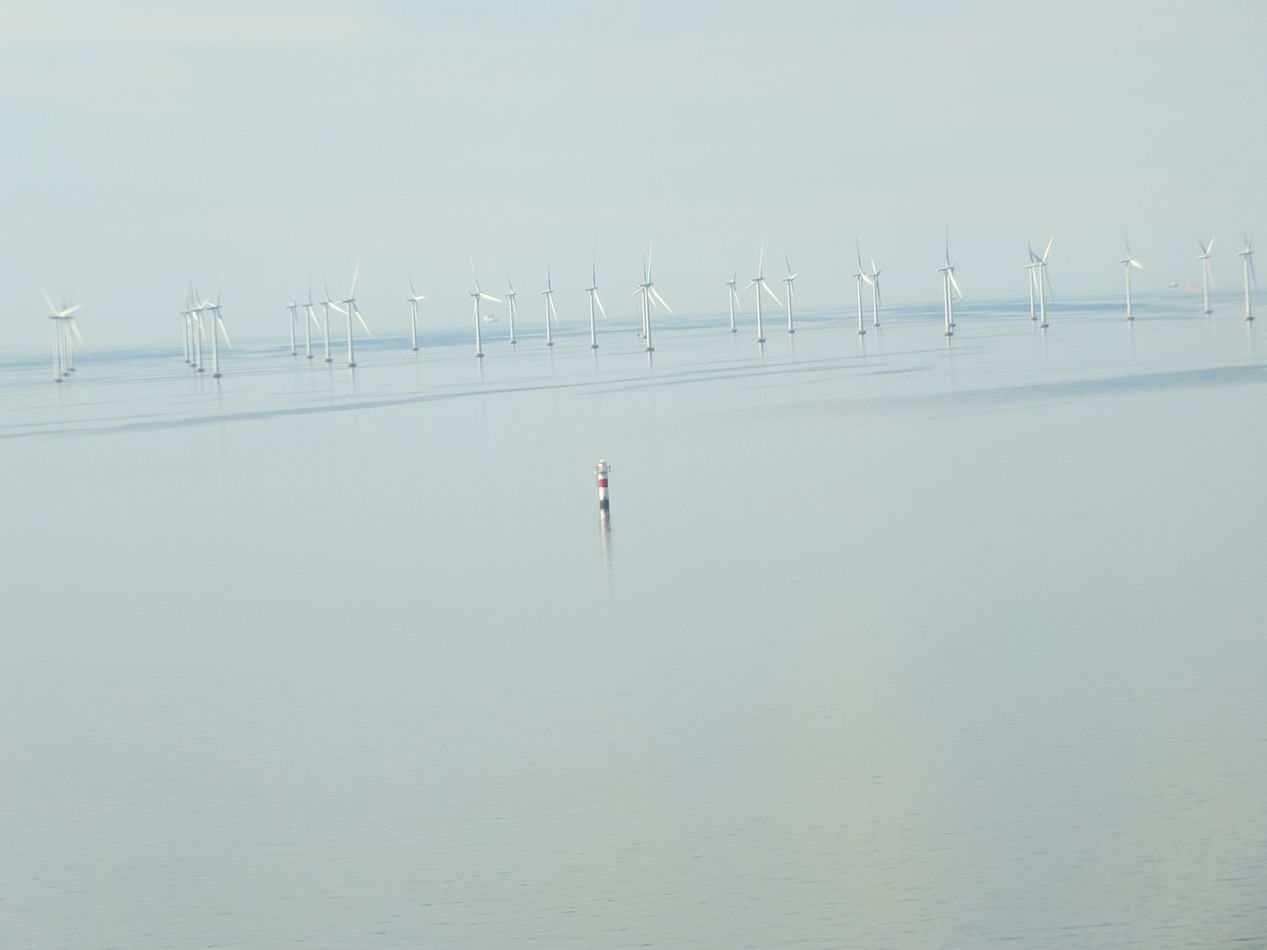


In order to visit Oslo, we had to reach the city first. We had previously decided to take the train north from Copenhagen to take advantage of the Eurorail pass that I still held, and we figured that the scenery on the train ride would be its own reward. The trip took about seven hours in total including a stop in Gothenburg, Sweden in order to change trains. The early portions of the ride had some of the most dramatic sights outside the window, as the train crossed over the Øresund on a huge bridge that was several miles long. There were dozens of gigantic windmills out there in the water generating power, and not the old-fashioned wooden ones that are associated with the Netherlands. These were modern industrial structures built of steel and plastic, picking up the wind as it blew across the Baltic. We weren't expecting to see those although I did recall spotting some out in the water from the plane trip a few days earlier. When there was nothing to see out the windows, I spent time playing a game of FTL: Faster Than Light on my little notebook computer, which had Liz rolling her eyes and taking candid pictures with her phone.
Gothenburg is Sweden's second-largest city and serves as the rough halfway point on a trip between Copenhagen and Oslo. We only stopped there for less than an hour, enough time to get lunch and then board a different train for the second half of the day's journey. This was the only time that we spent in Sweden on this trip, although I had visited Stockholm and part of the Swedish Arctic back in 2009 on a previous vacation. Finland remains the only Scandinavian country that Liz and I haven't had the chance to visit yet - hopefully someday! The train ride north of Gothenburg was highly picturesque, diverting inland and no longer following the coastline but often passing through small towns and a seemingly endless number of lakes. There was a beautiful little town names Sarpsborg where our train passed right through the center, crossing over a river with lakes on every side. I don't have any pictures from Sarpsborg unfortunately, so you'll have to take my word or check it out with a Google search.


We arrived at the Oslo Central Station (Oslo Sentralstasjon) in the afternoon, within easy walking distance of our hotel and the center of the city. Compared to the other train stations that I had been visiting on my trip, this was a moderately sized location, significantly smaller than some of the gigantic train hubs in other European cities. It was predictably easy to navigate though, and we would end up grabbing breakfast or lunch inside on several occasions. The station had a large open space outside facing the rest of the city, and this huge statue of a larger than life tiger. There was a plaque explaining the rationale behind why this tiger was located outside the station, which is apparently due to the fact that Oslo is colloquially known as the "Tiger City" (Tigerstaden) after its use in a 19th century poem by the Norwegian writer Bjørnstjerne Bjørnson. I think this is one of those things that Norwegians will understand and visitors will be left scratching their head about. The tiger was certainly a popular attraction, as there were always kids climbing on it and families posing for pictures every time that we passed by.

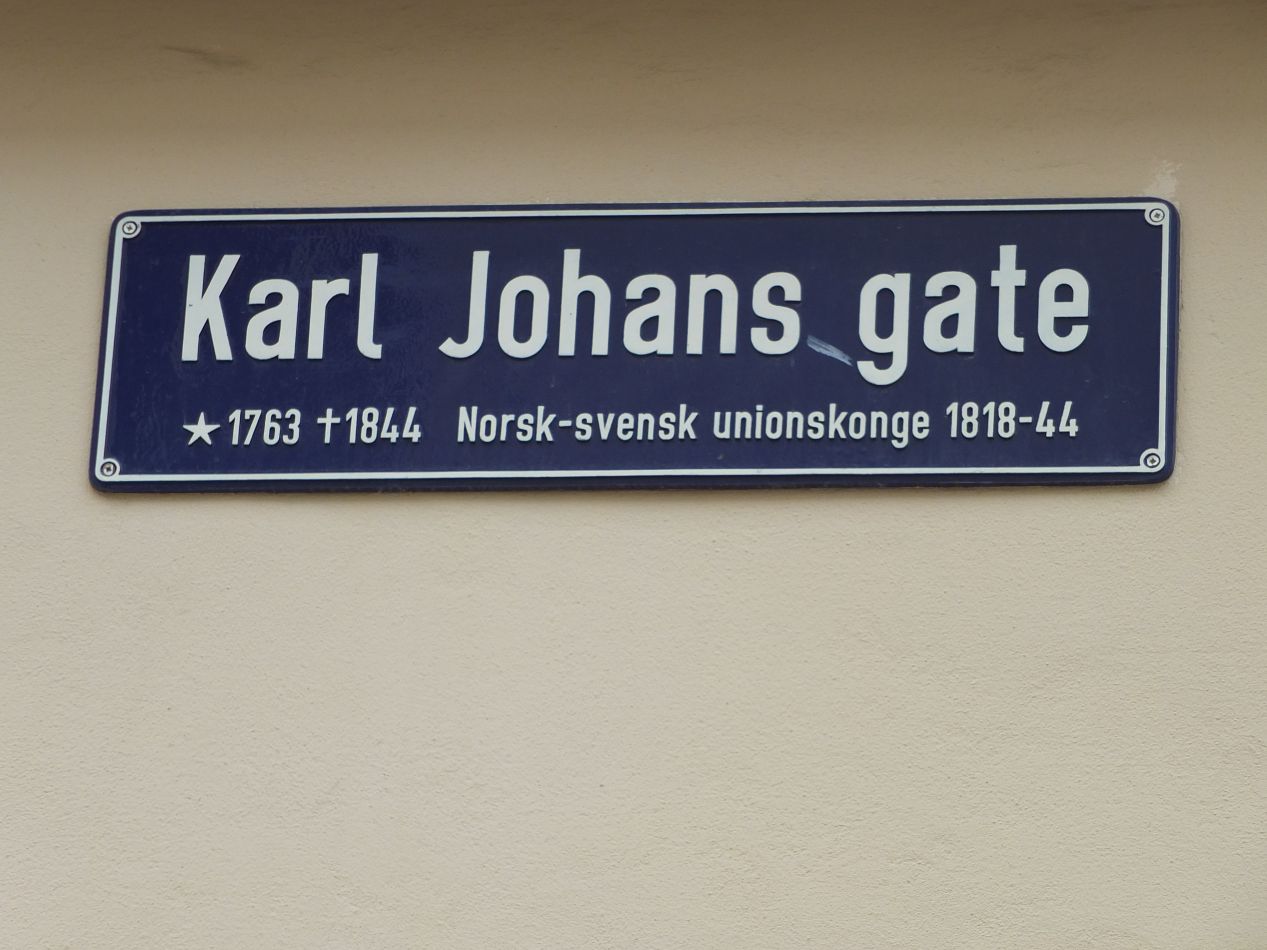
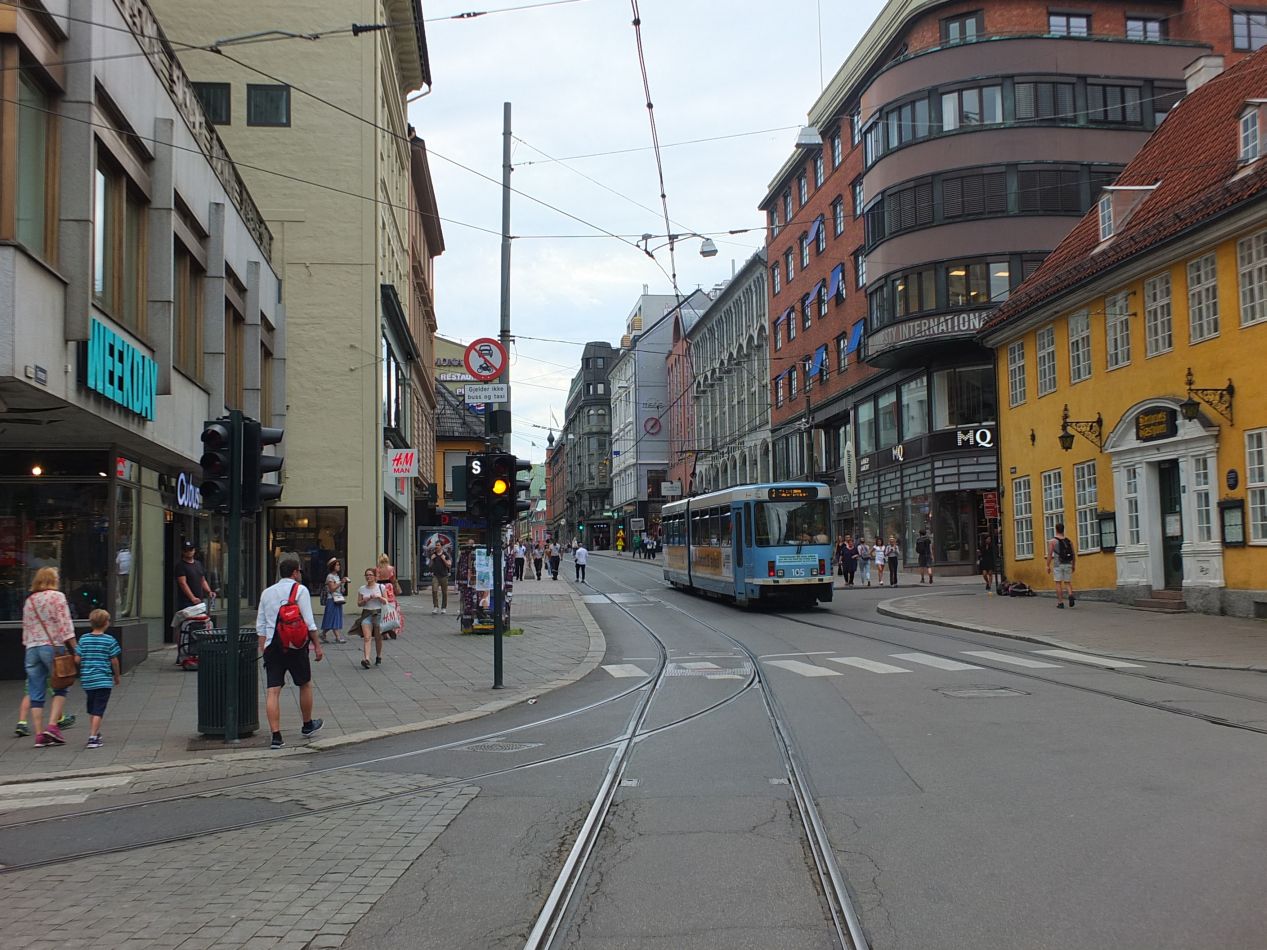

After we had a chance to check into our hotel and drop off our luggage, we headed out into the city to walk around a bit and head down to the waterfront. We were staying very close to Karl Johans gate, the central street that serves as the main thoroughfare for Oslo. The oldest part of this street has been around since the city's founding, but this section where we were located was built in the 19th century as Oslo expanded outwards as a city. Karl Johans gate connects together the Central Station with the Royal Palace, which is located up and over a hill, down into a small depression, and then up at the top of the next hill. This street is also the home to some of the city's fanciest shopping and restaurants, and it was bustling with pedestrians on this evening. I took a picture of one of the more obviously tourist-friendly stores named the Troll Shop. Norway as a country is obssessed with trolls, which can be found as souvenirs on sale everywhere. I tend to think they're a little bit creepy looking, but the trolls were undeniably popular everywhere that we went in this nation.

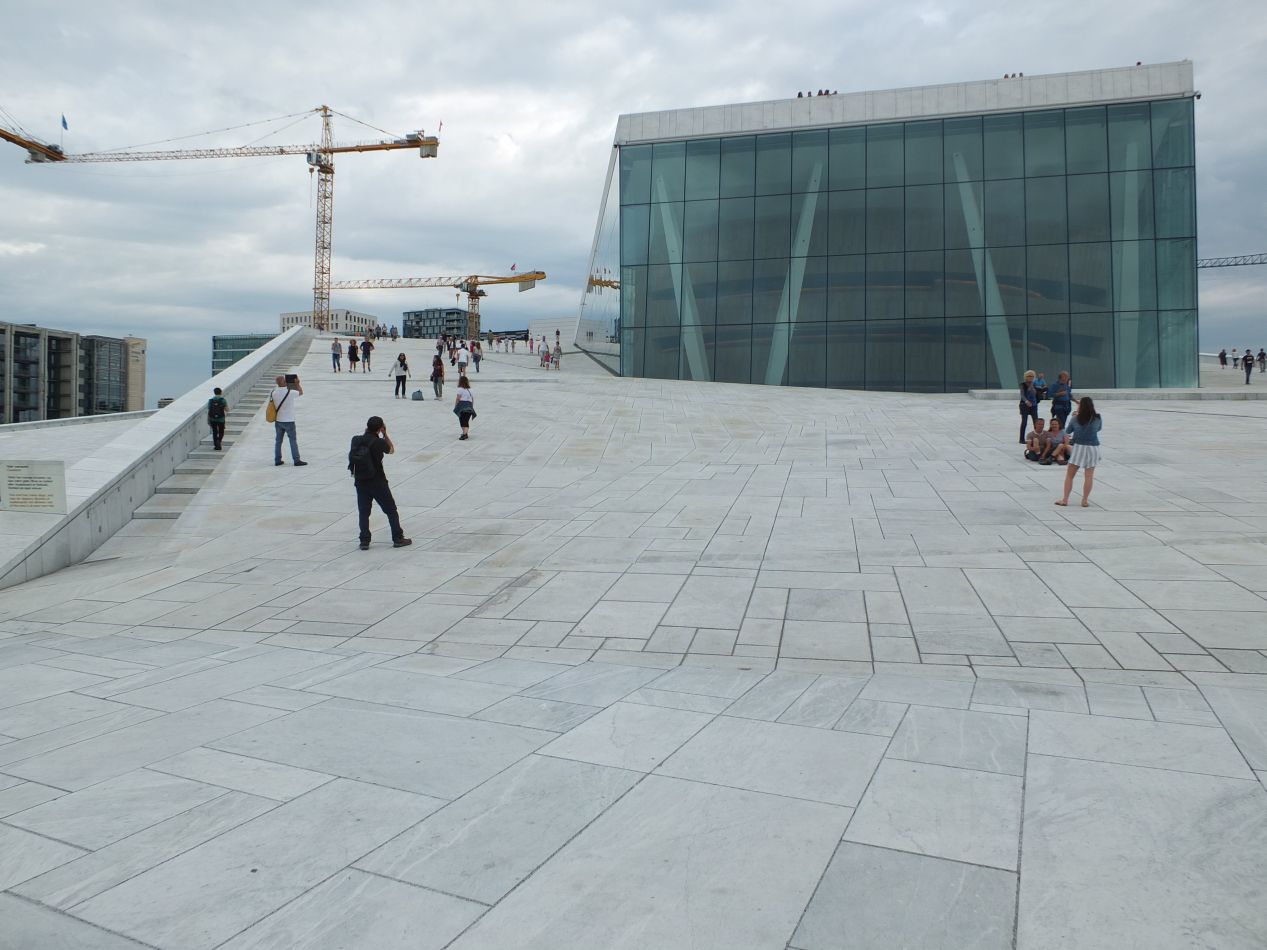


From there we walked down to the waterfront, where we were drawn towards this unusual-looking white building. This was the Oslo Opera House (Operahuset), home to the city's opera, ballet, and theatre companies. Much like the opera house in Copenhagen, this is a structure built recently between 2003 and 2007, and done so at an enormous cost of roughly $750 million, although Wikipedia claims that this was ahead of schedule and under the allotted budget for the project. This is another one of those crazy modern architecture designs with all sorts of unusual lines and angles that defies traditional characterization. The building is covered in white granite and is designed to appear as though it rises from the waters of the harbor. We were impressed at the way visitors could simply walk up the side of the building onto the roof for panoramic views of Oslo's waterfront. It was a little bit tricky climbing that inclined surface, which was a little bit slippery due to the damp conditions. The views at the top were impressive though, and more than worth the hike upwards.

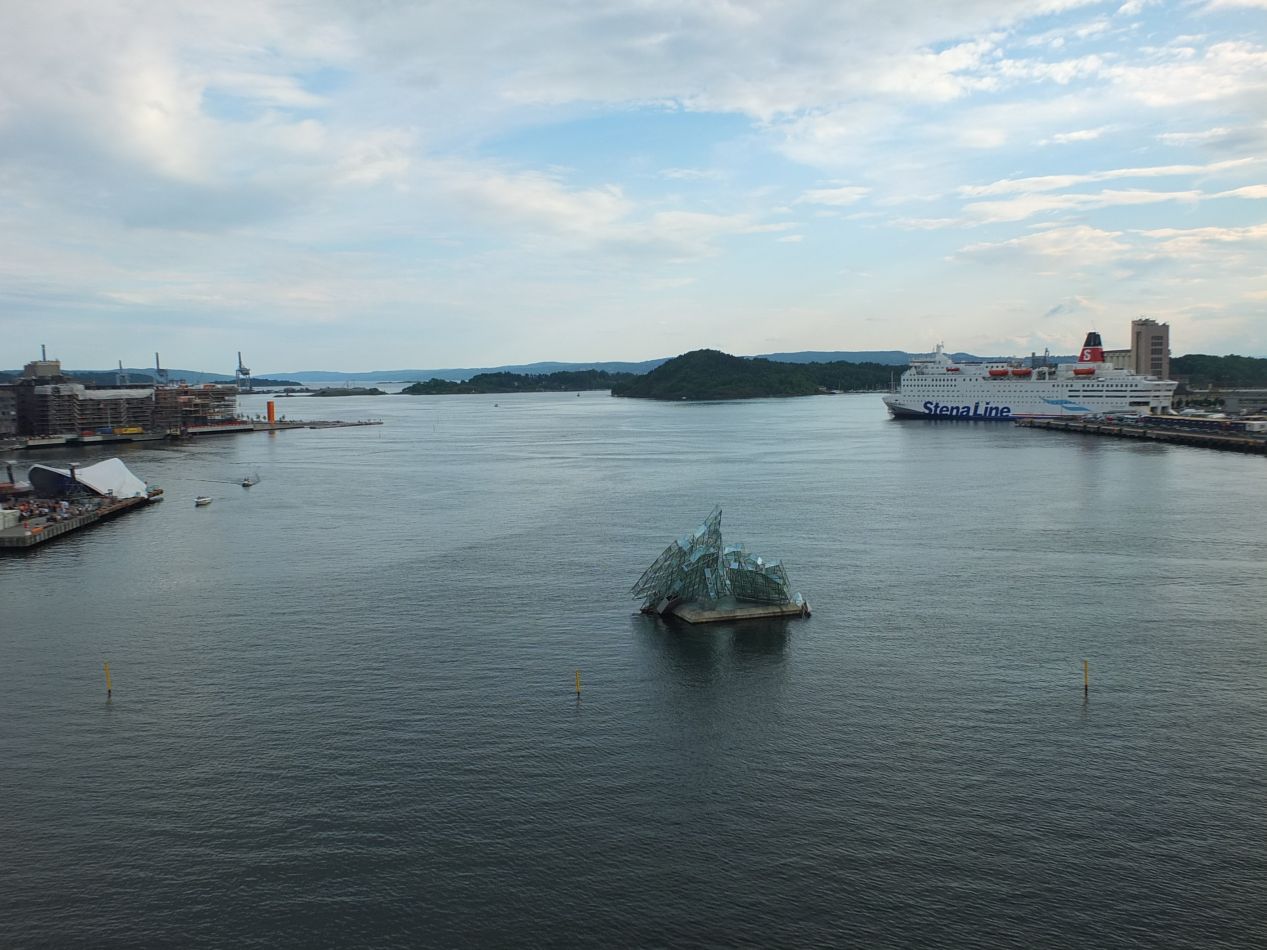


The glass thing that looks like a little iceberg is apparently a permanent floating art installation. It bobs in the water and moves around in response to the winds and the tides to present a different face to visitors on each trip. Beyond it, we could see out into the Oslofjord, the narrow body of water that connects the harbor at Oslo out into the North Sea. My understanding is that this is an excellent deep water harbor, and large ships like the one above travel right into the sheltered waters here. On the inside of the opera house, everything seemed to be designed out of glass or marble or wood paneling. While there were no performances taking place, we were still able to walk through the lobby and have a look around. This was a beautiful building, if a little bit strange, and it would be a wonderful place to see a performance. We've been able to see a number of shows at the Kennedy Center in Washington DC, and it has a lovely location on the Potomac River, but it can't compare to the natural scenery of the opera house in Oslo.

We had pizza for dinner this evening at a small restaurant attached to our hotel. We would have dinner at this location twice in three nights, and not because we loved pizza that much. (Well, I do but Liz not so much.) I'm highlighting this because it's important to point out the one unpleasant fact about Norway: the country was incredibly expensive to visit.  It was right up there with Switzerland as the two most expensive places that I visited, and nowhere else even came close. We kept coming back to this place because it was the most affordable location to eat, especially with the small discount from staying in the hotel kicked in. A standard entree in most restaurants cost the equivalent of $30, per person, and we couldn't engage in that kind of pricing for every meal. Even the fast food at the McDonalds in the central station cost the equivalent of $15 for the same combo meal that would cost about $5 in the USA. As beautiful as Norway proved to be as a country, we have to warn anyone thinking about traveling there - it's not a cheap place to visit.
It was right up there with Switzerland as the two most expensive places that I visited, and nowhere else even came close. We kept coming back to this place because it was the most affordable location to eat, especially with the small discount from staying in the hotel kicked in. A standard entree in most restaurants cost the equivalent of $30, per person, and we couldn't engage in that kind of pricing for every meal. Even the fast food at the McDonalds in the central station cost the equivalent of $15 for the same combo meal that would cost about $5 in the USA. As beautiful as Norway proved to be as a country, we have to warn anyone thinking about traveling there - it's not a cheap place to visit.
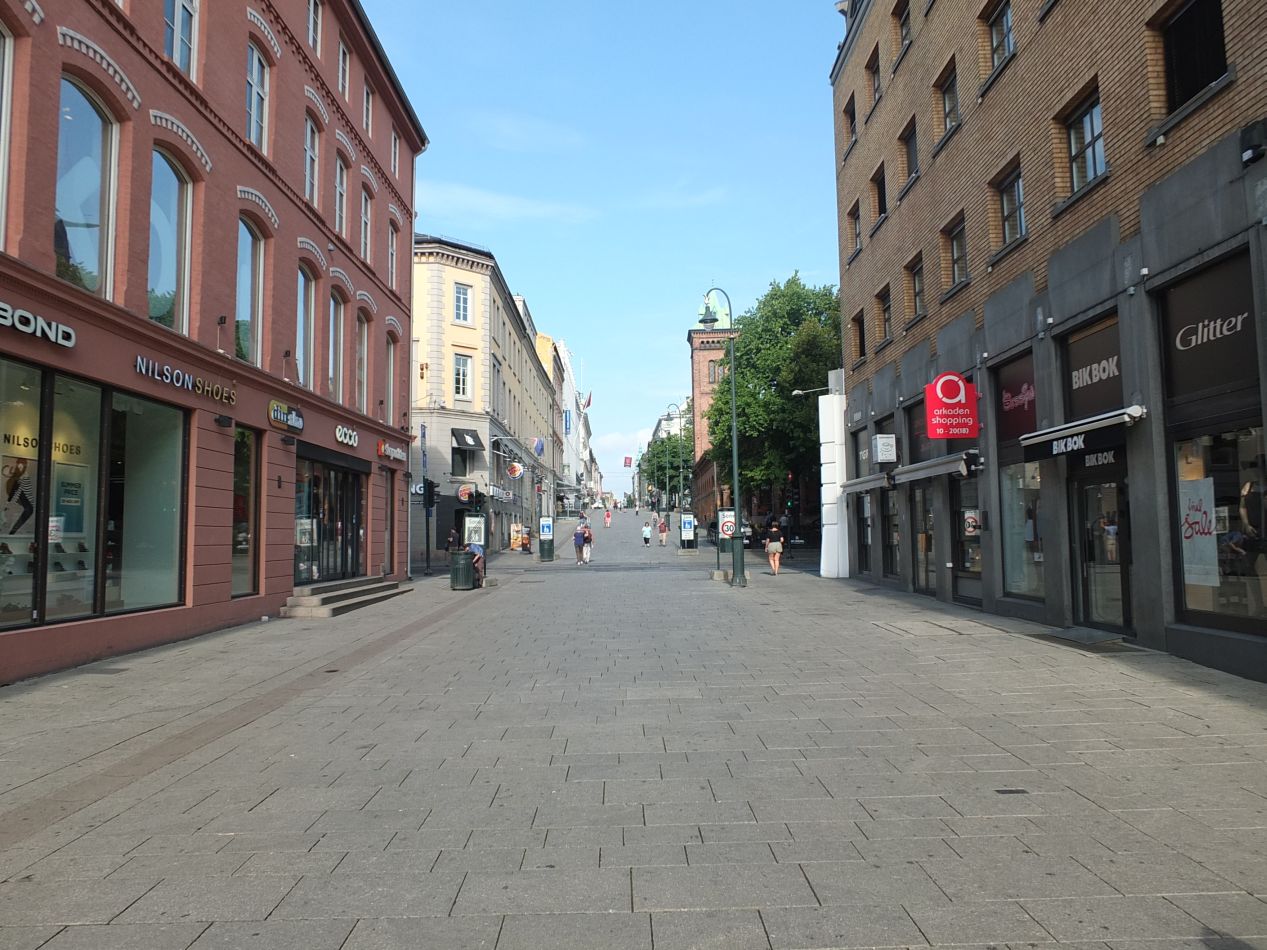
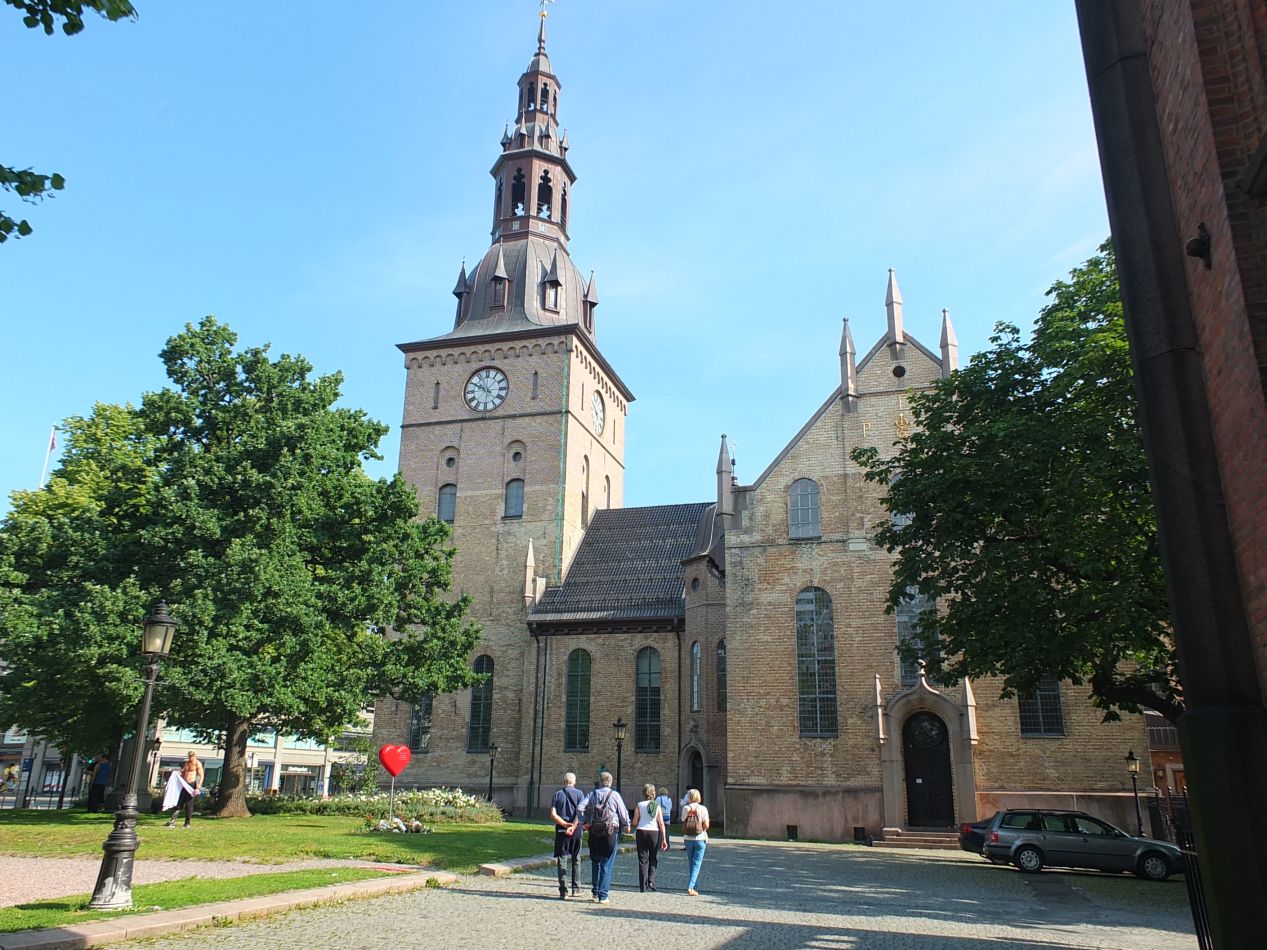
The next morning was the start of our first full day in Oslo. We left our hotel and walked to the west, towards the center of the city. Karl Johans gate was much less crowded with people on this Sunday morning and we were fortunate to enjoy sunny weather once again. As a first stop, we headed over to the Oslo Cathedral (Oslo Domkirke) a few streets away from the main thoroughfare. This is the main church for the city, used by the Norwegian royal family for state ceremonies and official weddings. The current church dates from 1697 and was the third cathedral to be located in Oslo, replacing two earlier versions that burned to the ground in fires. The exterior of the church was constructed out of brick and it has a bit of a rough look to it, very much in keeping with the Scandinavian climate. Oslo Cathedral would never appear on a list of beautiful church designs - this is more of a case of function than form. We had the good luck to be passing by the cathedral in between Sunday services, which allowed us to head inside and take a look.




Oslo Cathedral was surprisingly small on the inside considering its important ceremonial status. A few hundred people could fit inside at once but certainly not thousands. The distinctive feature of the cathedral was the colorfully painted ceiling, with religious figures marching around the edges and a brilliant sunburst of some kind above the chandelier in the center of the building. I guessed that the bright colors were likely intended to provide some levity during the long and gray winters that grip the city every year. (Oslo is located at 60 degrees north latitude, about the same as Anchorage Alaska, and there's a lot of darkness in the winter. We were enjoying some very long daylight hours here during the summer.) There was also an elaborate pipe organ hanging above the tiny second floor balcony in the rear of the church, and an ornate painting behind the main altar in the front. It was a neat church overall, and one of the more memorable ones that I had come across on this trip. I couldn't recall anywhere else that had a similar ceiling design, and the small size of this putative cathedral was also unique when compared against all the Gothic monstrosities that I had seen earlier.




Back now on Karl Johans gate once more, we crested a hill on the eastern side of the boulevard and were treated to our first view of the royal palace off in the distance. The avenue that stretched before us contained more of the upscale shops and restaurants that dominate along Karl Johans gate, paired together with a series of official government buildings clustered here in the downtown. The closest such building was the Norwegian Parliament (Stortinget), the one made out of large bricks with the rounded front entrance. We might have stopped to take the tour of the parliament, but it was only offered on weekdays and wasn't available. Much like Oslo Cathedral, this was a sturdy, dignified, and rather small building in comparison to other legislatures located elsewhere. The Norwegian Parliament overlooks a public park with gardens and a fountain in its center. There were already people relaxing outside and enjoying the good weather in the park. In the winter, the small pond in the center freezes over and gets converted into an ice skating rink. It was a pleasant area to stroll through en route to our next destination.


We were headed down to the waterfront again, this time a bit further to the west than the previous night when we had visited the opera house. The huge brick building with the two towers rising up on each side was the Oslo City Hall (Rådhuset), an important building that we would be returning to see a little bit later. The city hall building sits right next to the water, where we were planning to catch a ferry over to Dronningen on the other side, the home of the Viking Ship Museum. The ferry would also be its own reward, providing us with beautiful views of the harbor as we crossed. We were thinking that we would stop and visit the city hall building if we had a long wait for the ferry, but it turned out that there was one just about to leave and we were able to hop aboard immediately. More good travel luck - this was shaping up to be a great day.




I always love any kind of travel by boat, even a short jaunt like this one. There's always a fresh breeze dancing over the waters, and the open spaces that stretch toward the horizon give off a feeling of adventure, the feeling of setting off on a journey to strange and new places. (I might feel differently if I were caught in open water during a bad storm but that's a problem that hopefully I'll never have to face.) The ferry that crossed the Oslofjord gave us a number of great views, starting with the view back to the city hall itself. The building is an easy landmark to spot, between its tall height and those distinctive double towers. We also had a good view of the Akershus Fortress, the structure built to defend the harbor in an earlier period. It was perched up on a hill to the east of the city hall, and we planned to check it out later on after returning back across the water. Up ahead at our destination was the ferry stop of Dronningen, which appeared to be located in a neighborhood with some very fancy houses. The white building with the square tower on the right side of that last picture is a summer palace of the royal family known as Oscarshall which has been converted into a museum open to the public. This was clearly an expensive residential area, located on a peninsula that jutted out into the harbor off to the west of the city center.

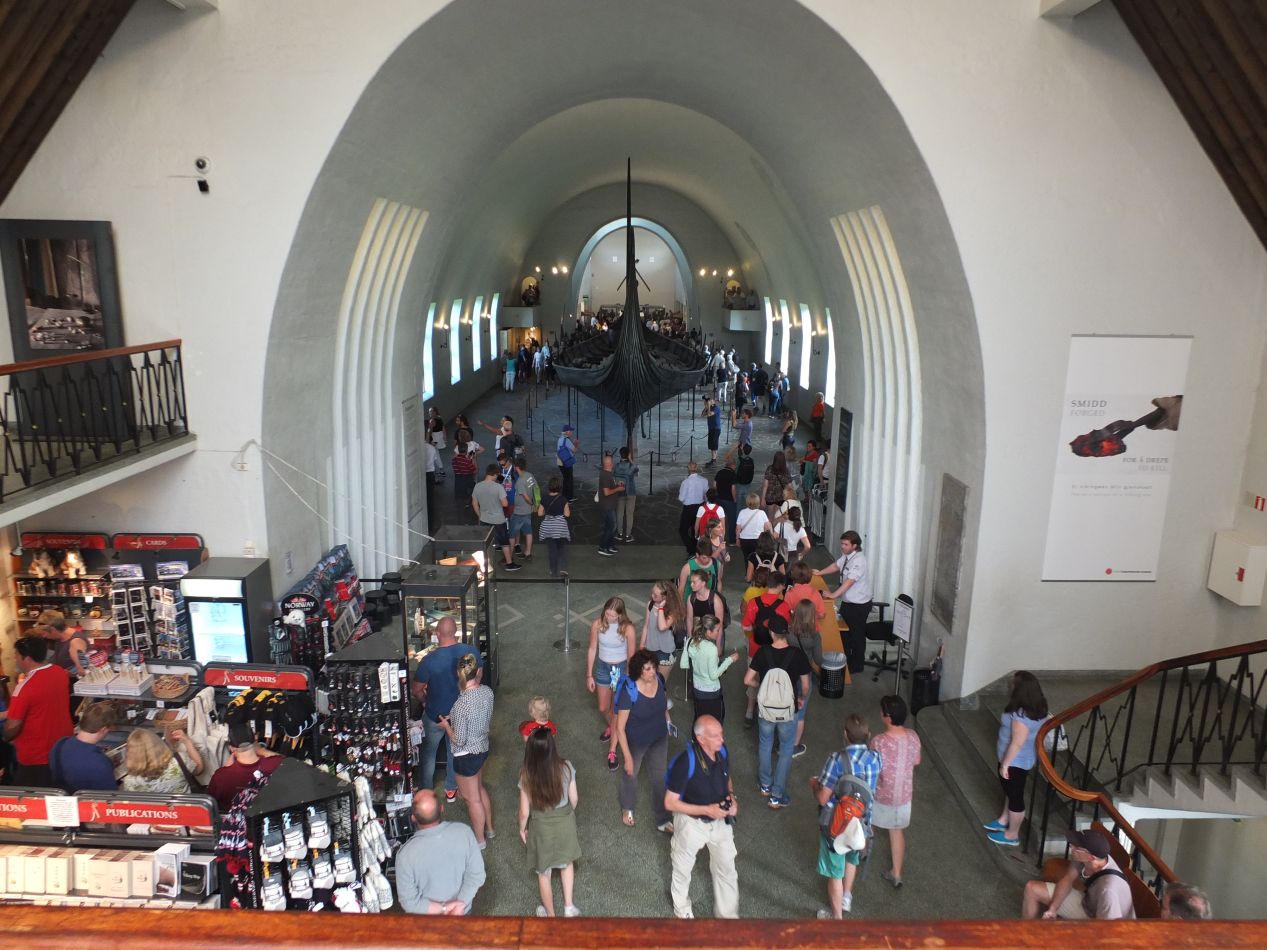


Our destination was the Viking Ship Museum (Vikingskipshuset), one of about a half dozen museums located together in this area. We had our choice about which museum we wanted to see in the limited time available, and this one seemed like the most interesting by far. There's also a museum dedicated to Norwegian polar expeditions, a museum showcasing the Kon-Tiki boat of adventurer Thor Heyerdahl, a museum dedicated to folk culture, and a general maritime museum for whatever wasn't covered in the other ship museums. A visitor easily could have spent all day here seeing these places. As for the Viking Ship Museum, we were struck right away by the structure of the building housing the ships. It looked a lot like a church with its cross-shaped layout, and we discovered that the building had indeed originally been a church before being converted into a museum. The long sides of the structure were well-suited to displaying the long Viking ships, with one dedicated to each of the three "arms" of the building. These three ships were the product of a series of archaeological excavations, with the first such excavation dating back to the late 19th century.

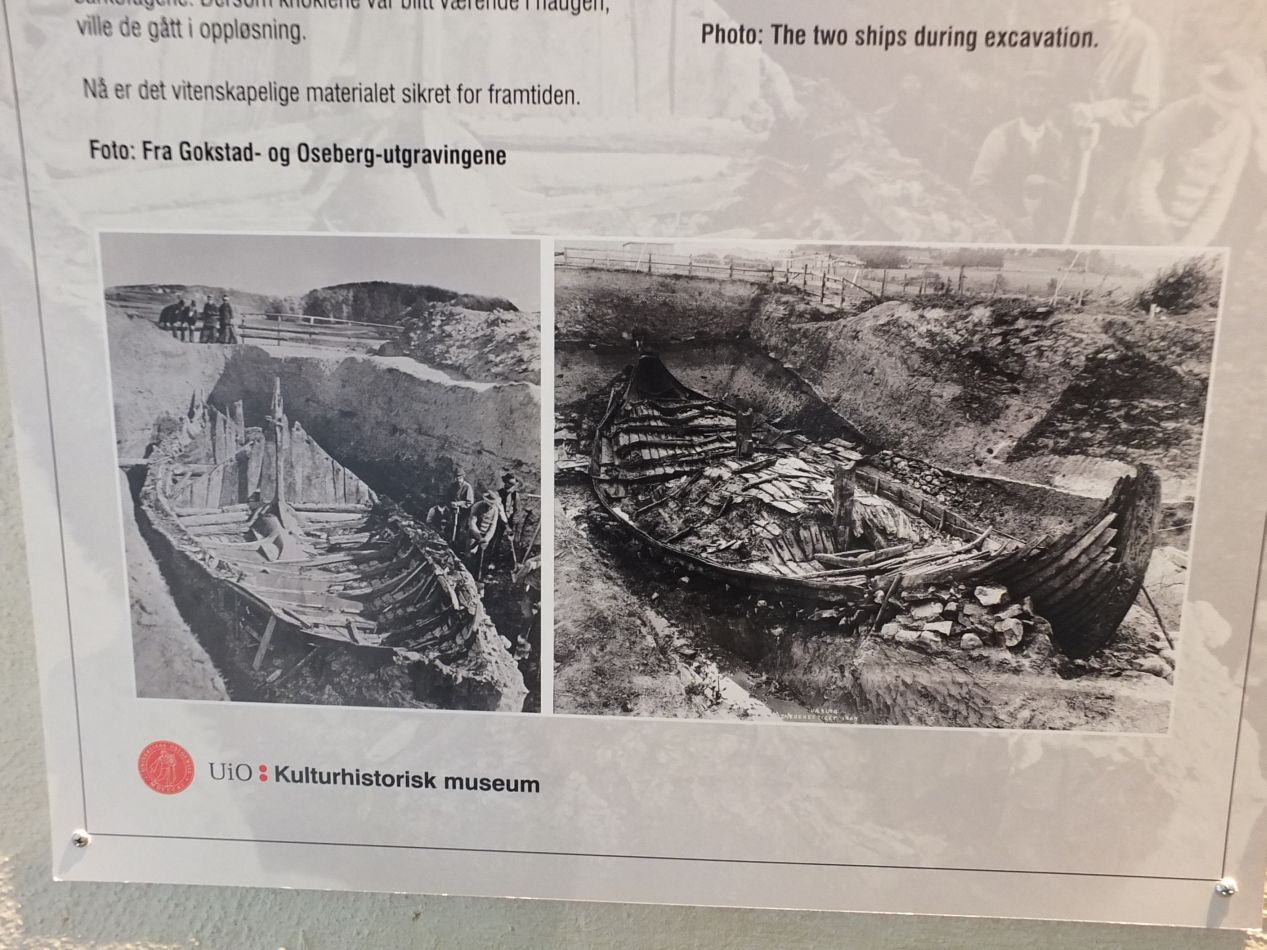


The three ships all date from the Viking period sometime in the 8th or 9th centuries. The fanciest of the three ships, the one with the spiral design at the front and back of the ship, was apparently a pleasure craft that didn't see much in the way of real use. The other two less glamorous ships were more of the real deal. It's not entirely clear why these ships were buried underground in gigantic gravesites, with the best explanation being that it was part of a religious ceremony related to the afterlife, in similar fashion to the huge tombs that were built for the Egyptian pharoahs. These ships were in extremely rough shape when they were first excavated, and the display versions are the result of careful restoration work. The craftsmanship behind these ships is still incredible, considering that the wood is roughly 1200 years old and largely held together despite being buried for over a thousand years. The museum holds a number of other artifacts from the Viking period that were buried along with the ships, wooden carvings and articles of clothing and this large wooden cart. The museum was a really cool place to visit, and the collection is in the process of moving to a new and larger building that will have more display space. This was one of the highlights of visiting Oslo.

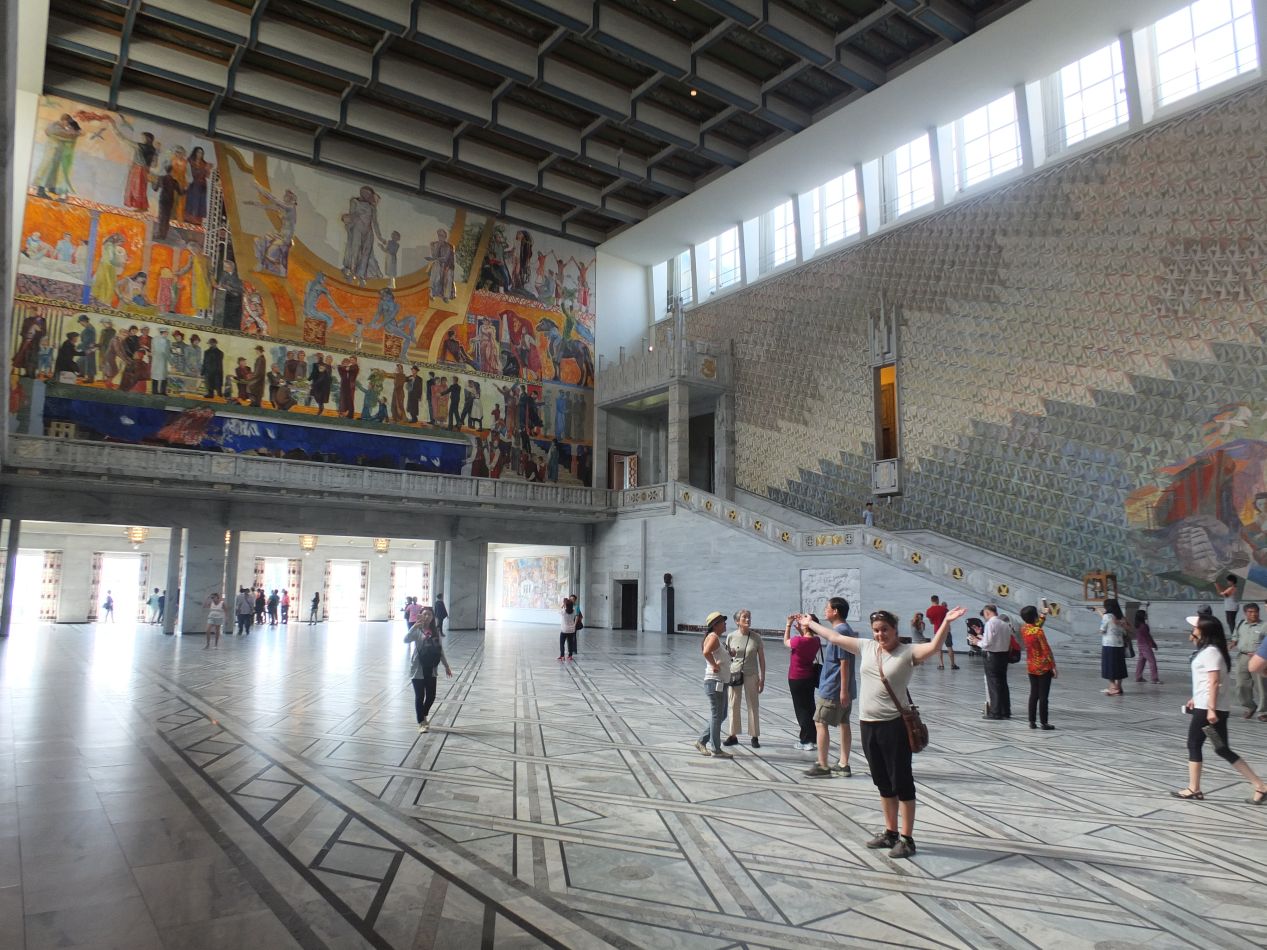


We returned back across the harbor on the ferry, and this time went over to see the city hall building more closely. It was open to the public and turned out to be more of a tourist attraction than we were anticipating, with lots of visitors strolling around through the central corridors. Oslo City Hall dates back only to 1950, when a new building was constructed to replace the much smaller city hall that had been in use previously. The exterior was created in functional style with red bricks, and most of the administrative work involving the city government takes place in the two side towers. The central portion of the building is a different story, however, with a huge central hall built mostly out of white marble. There are a series of colorful paintings along the sides of the chamber, perhaps inspired by the ceiling designs in Oslo Cathedral, depicting in this case the city of Oslo and its people during the early decades of the 20th century. The halls surrounding the main room were mostly constructed in the same style, with more white marble and high ceilings accented by bright, colorful paintings. The main hall came as a major surprise to us; you would never think that this was sitting inside such a bland looking exterior.

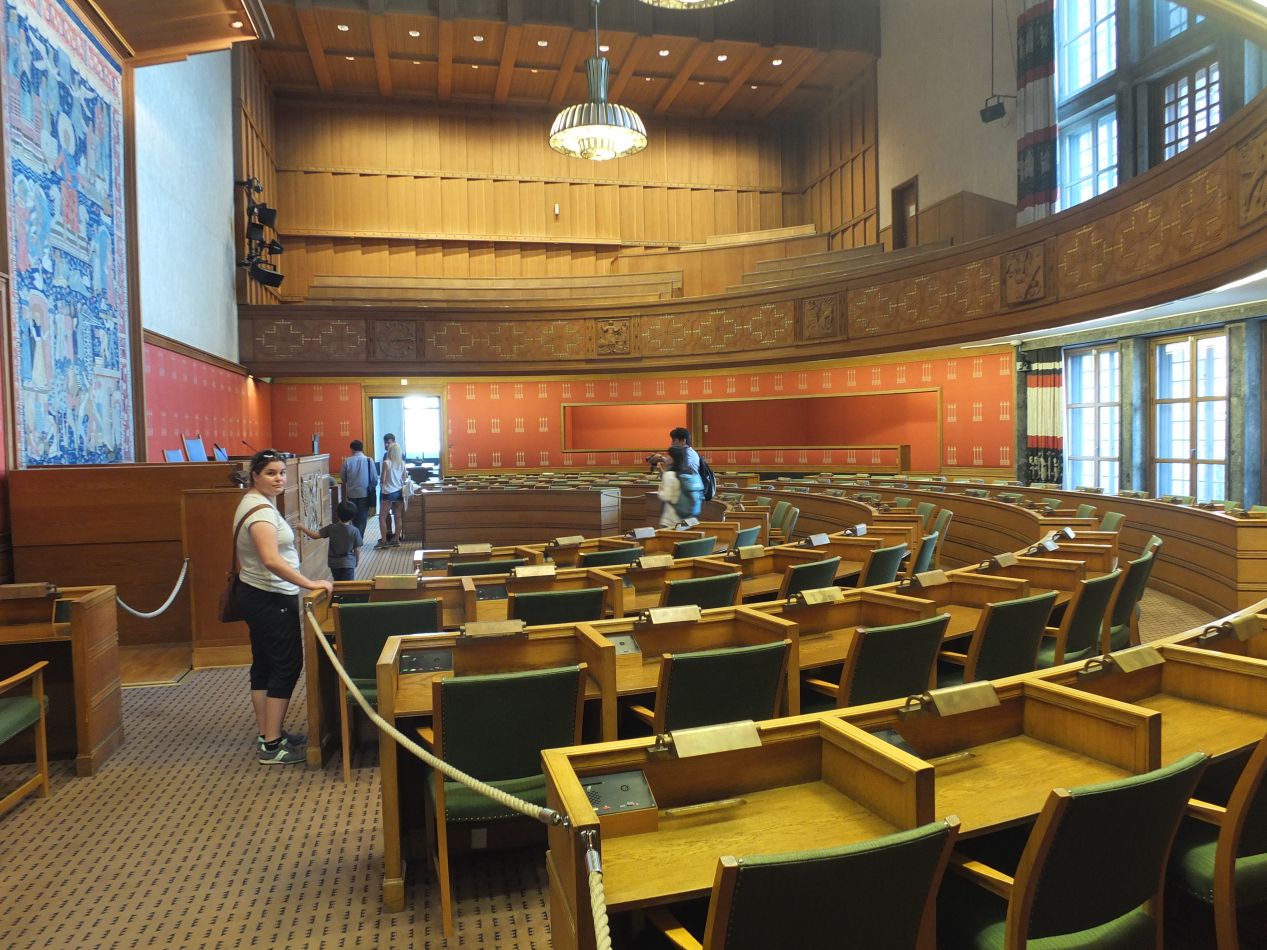


These are some more pictures of the hallways running around the main chamber on the upper floor of the building. There's a small legislative chamber up on the second floor where the Oslo City Council meets, with the room using a standard circular design around a central lectern. Nothing too fancy but a polished, professional looking room. Some of the other halls were much grander, and looked to be places where visiting dignitaries are greeted. Oslo City Hall plays host to many of them every year, since this building's biggest claim to fame is staging the awarding of the Nobel Peace Prize. On December 10 of each year, the main hall is transformed for the ceremony as picted above, with the Norwegian royal family and the prime minister playing host. This was another unexpectedly amazing thing to see on this trip, getting to visit the place where the Nobel Peace Prize is awarded each year. The city hall building turned out to be a lot more interesting that we had been anticipating. 




After touring the city hall, we stopped to eat some lunch and then proceeded over to the Royal Palace (Det Kongelige Slott). The royal palace sits atop a hill on the western side of Oslo's downtown, and Karl Johans gate runs from here in a straight line past the public park and Norwegian Parliament towards the main train station in the distance. The palace was constructed over two decades between 1825 and 1849, with the intention of serving as the primary residence for the royal family when they were visiting Oslo. Norway was still part of Sweden at the time, and this was only one of many residences in use. It became a more important structure when Norway gained independence in 1905 and Prince Carl of Denmark was invited in to become King Haakon VII of Norway. He was the first monarch to make use of this building as his primary home.
The building itself is smaller than many of the other royal palaces located elsewhere in Europe, although still far from cramped with 173 rooms in total. The Norwegian royal family does still live here, although as we had seen with the Amalienborg Palace in Copenhagen, they spend most of the summer at other residences during the height of the tourist season. While the palace was open for tours on this day, there was a substantial wait and the staff didn't allow photography of the interior, so we opted to move on and visit other sights. We did have the chance to see some of the Royal Guards patrolling outside in their ceremonial black uniforms, as well as the park surrounding the palace known as the Slottsparken. This is another place where we wished we had more time; with only three days in total, we had to pick and choose all too often.

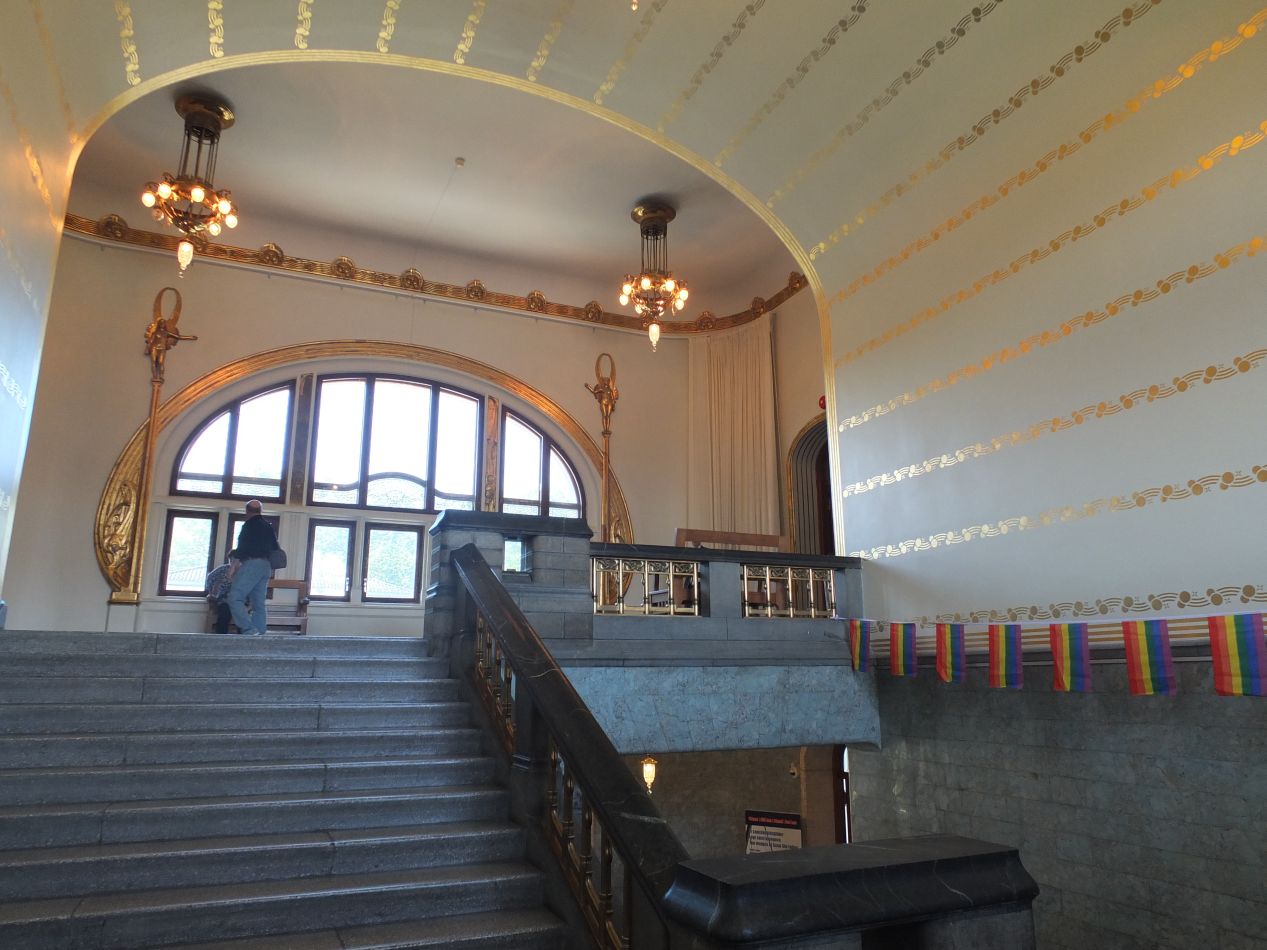


We stopped next at the creatively-named Historical Museum (Historisk museum) in part because our tickets to the Viking Ship Museum had included entry to this location as well. This was one museum that proved to be a disappointment. The interior was sparsely attended, almost deserted, and the museum collections felt seriously out of date. There were a number of anthropology-themed exhibits on cultures from other parts of the world that looked like they were produced in the 1960s or 1970s and came across as a bit cringe-worthy in their portrayals of non-Western peoples. There were some neat things here and there, like an exhibit on Norwegian coinage and this owl artifact unearthed in an archaeological dig, but overall this hadn't been the best place to visit. In retrospect, we would have been better off skipping this place and taking the tour of the Royal Palace instead. We also might have stopped to see more of the National Theatre, which had this grand exterior as we passed by. It was closed for Sunday though which ruled out that potential option.

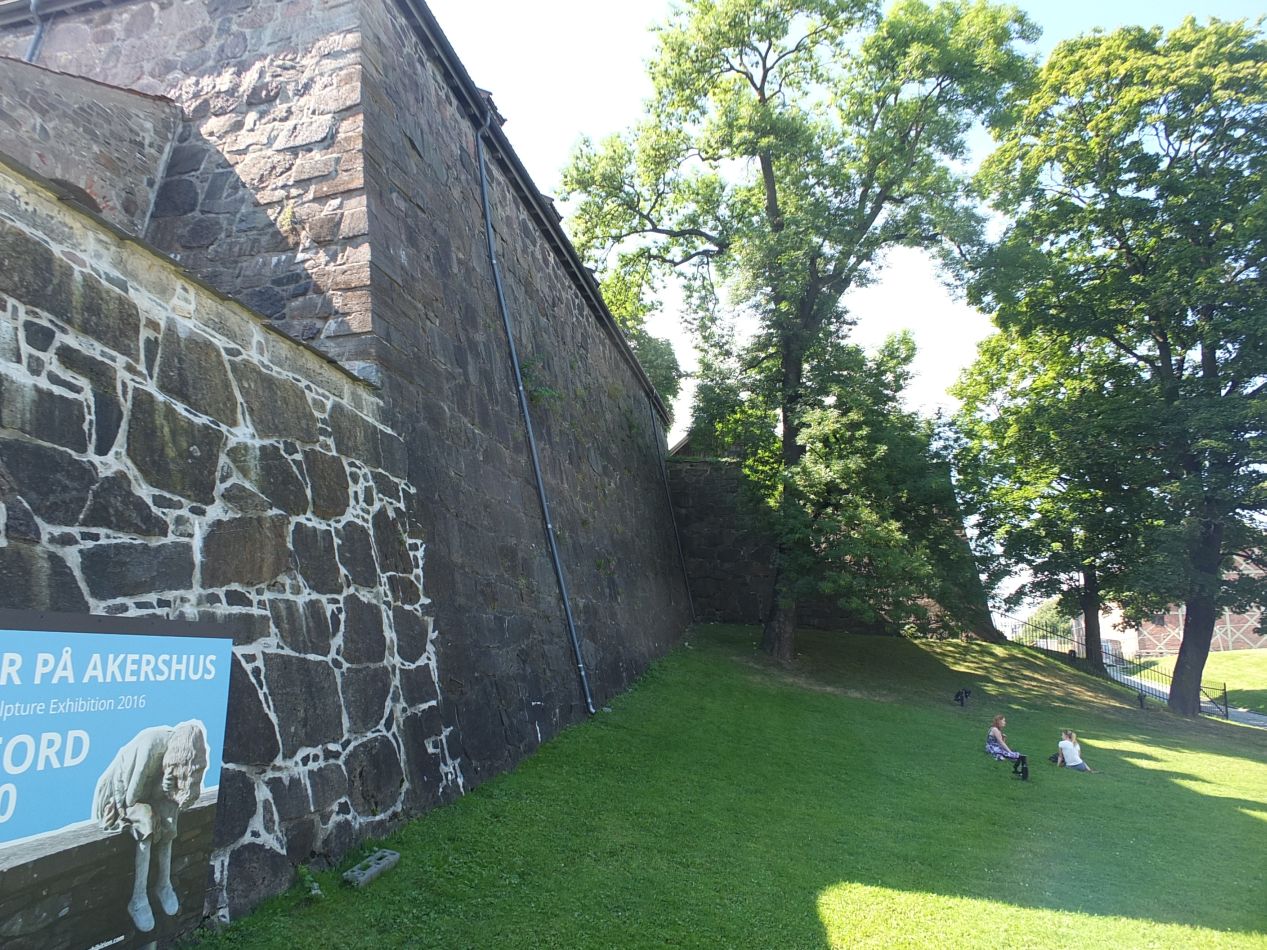


With afternoon beginning to fade away, we walked over to the Akershus Fortress (Akershus Festning) on the eastern side of the harbor, the same place we had seen from the ferry earlier in the day. Like most other fortifications, this was located up on top of a hill where we were treated to more sweeping views of the city. The cannons overlooking the harbor served to demonstrate how the approaches to the city would have been defended in an earlier era. The original structure at Akershus dates back to roughly 1300, when there was a medieval fortification of some kind located in this spot. Most of the current structure dates to the early modern period, when it was extensively rebuilt during the 17th century. It was never successfully captured by an invading army, although Akershus was surrendered peacefully to the Nazis when they took over Norway in 1940. At times this fortress has been used as a residence for the royal family and as a prison for convicts - although not for those two purposes at once! We stopped at the top of the fortress hill to rest for a few minutes and enjoy the quiet scenery. This was an ideal place to catch our breath towards the tail end of a long day of walking.

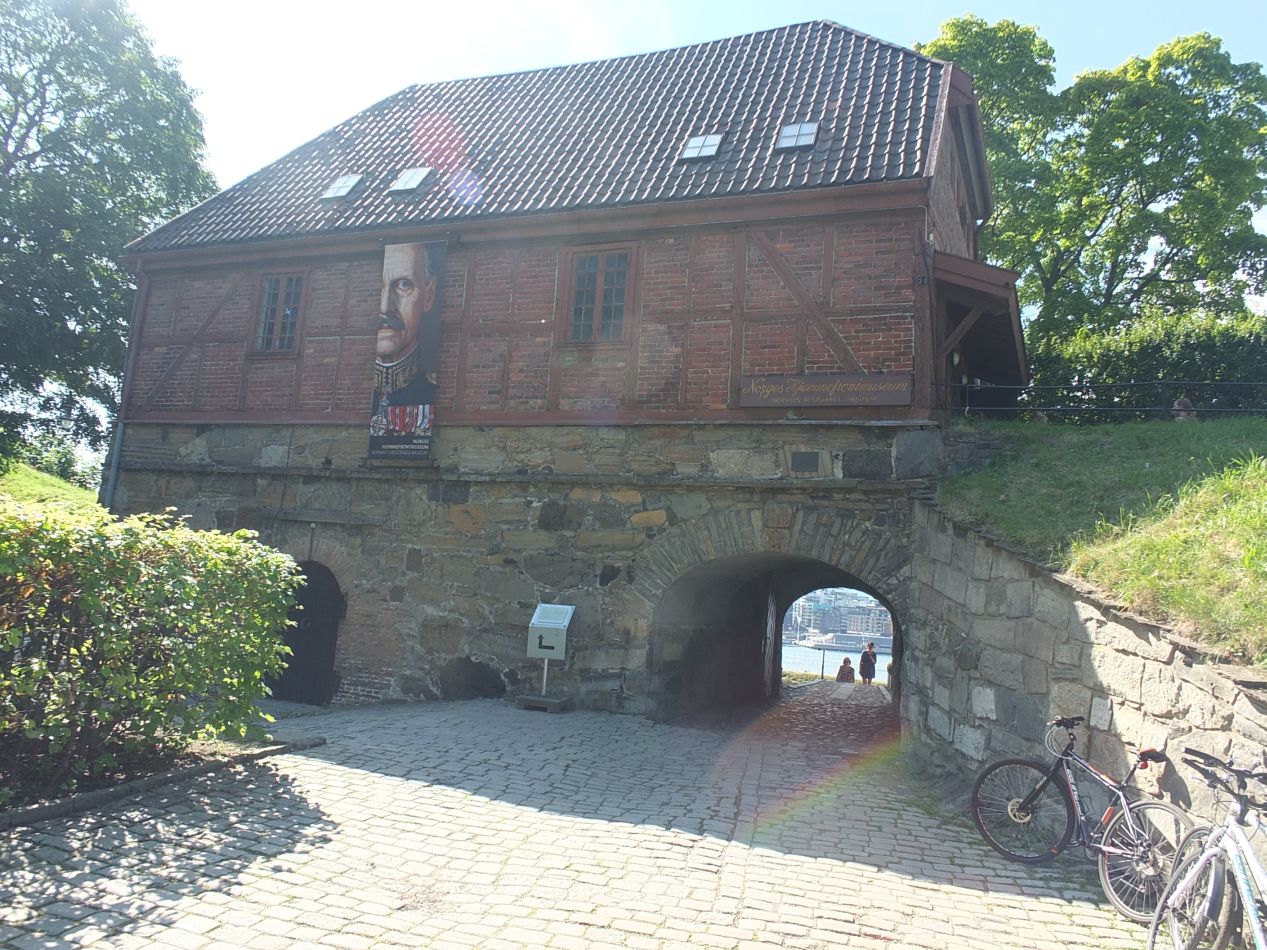


Akershus Fortress is made up of a complex of buildings grouped together behind the thick stone walls of the exterior. Everything was constructed out of stone and has the feel of great age to it, with the sense that these buildings had withstood the test of time immemorial and would still be there long after all of us are gone. We enjoyed walking around the outskirts of the fortress and taking in more of the outstanding views of the harbor. We wanted to take the fortress tour of the interior as well, but it was closing right when we arrived. The early Sunday closing hours had thwarted us here, which was unfortunate because there are some great pictures online of the main hall of the fortress and the small chapel located inside. There's also a crypt where some of the members of the Norwegian royal family are buried which I would have enjoyed seeing. Nonetheless, this was still a great place to visit, and we would have spent more time here if we could.
We might have continued sightseeing longer at this point, but all of the tourist attractions were closing up shop due to it being a Sunday evening. We went and had dinner instead, then went back to the hotel in preparation for another day of traveling. We were up early the next morning, preparing for our day trip to Lillehammer:


The former site of the Olympics is located about 115 miles / 185 kilometers to the north of Oslo, reachable in roughly two hours by car or train. We would be riding the rails again, with this being the last day that my rail pass remained active. This was a smaller train than the one we had taken from Copenhagen, and appeared to be designed more for local transport than long distance travel. The main thing that characterized this ride north was the presence of lakes, which we kept seeing constantly as we traveled into the Norwegian countryside. One lake named Mjøsa paralleled the tracks for a long time, with the head of the lake located up near the town of Lillehammer. The weather on this day was also cooler and more overcast, still good for travel but threatening the possibility of rain later. We were eager to arrive and see what sort of Olympic stuff would be on display at our destination.

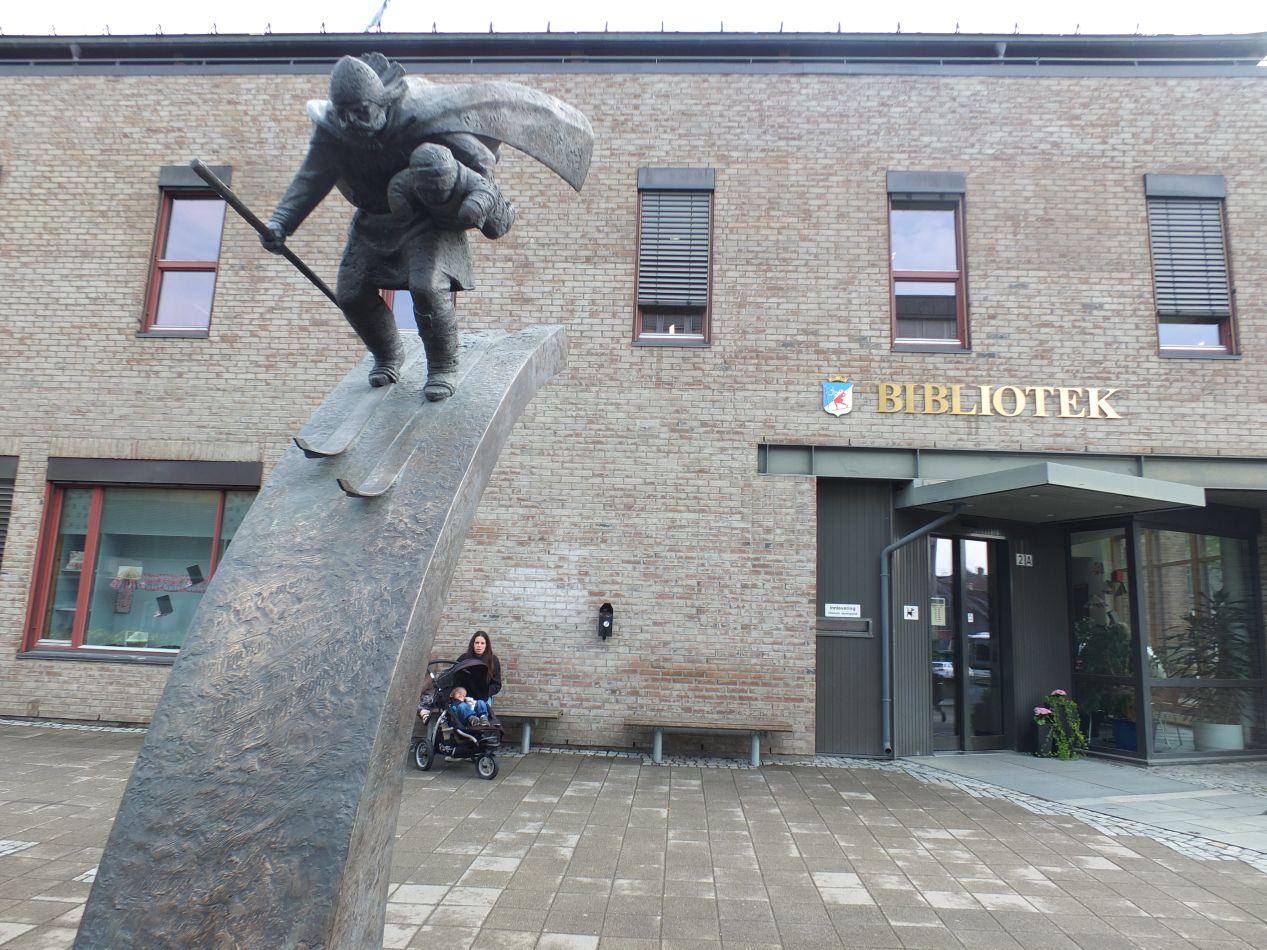


We were surprised to find that there was nothing at the Lillehammer train station that mentioned the 1994 Olympics at all. We were expecting Olympic signs and paraphernalia to be everywhere in Lillehammer, since that had to have been by far the most famous event ever to take place in the small town. In the United States, the Lillehammer games were famous for the Nancy Kerrigan/Tonya Harding iceskating scandal, which completely captivated the country for several weeks. And yet here in Lillehammer itself, there was virtually nothing to say that the Olympics had ever been here at all. No signs saying "Olympic Village this way!" (at least in English), no torches or rings or anything. I had previously visited three hosts of the Winter Games - Lake Placid, New York; Park City, Utah for the Salt Lake games; and Whistler, British Columbia for the Vancouver games - and all of them were practically drowning in Olympics stuff. Nothing here. Lillehammer looked like a charming small Norwegian town that could have been found in a hundred other places throughout the country. I was beginning to get a little bit nevous about this; Lillehammer was one of the places I hadn't researched as much, and if we had taken a two hour train ride out here for a total bust, this would be an expensive wasted day.

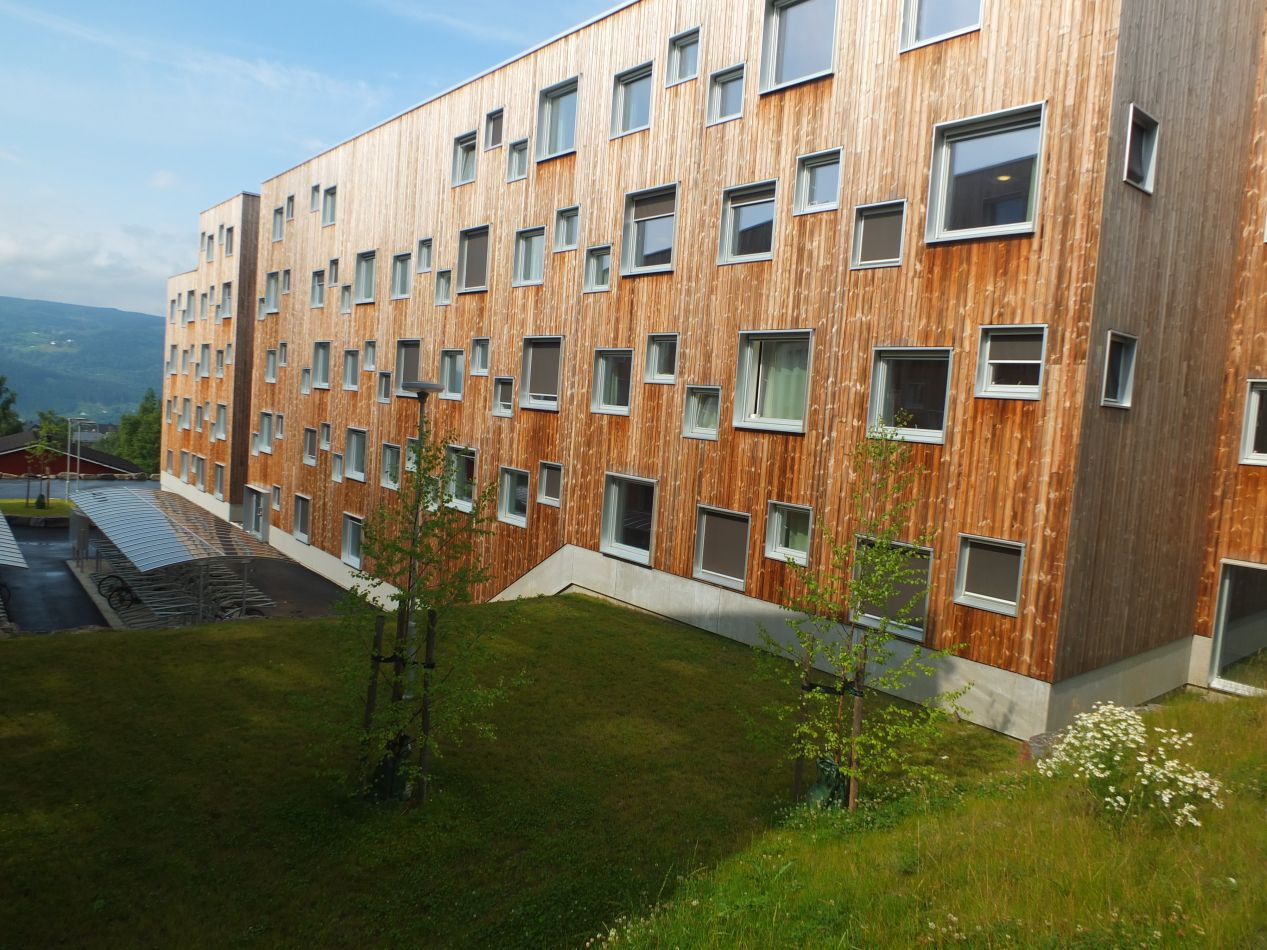


Fortunately, we finally began to see some of the Olympic stuff as we climbed up above the town proper. Lillehammer is built on a steep hill, perched next to the lake shore at the bottom and with the town rising up above it. I knew that the Olympic infrastructure was located up the hill from the train station, and as long as we kept climbing uphill we would see it eventually. We did stumble into the Olympic park eventually, again with no signs directing us there whatsoever. The wooden building with all of the windows was where the athletes were housed during the games; it is now used as student housing, which makes sense for the dormitory-style accomodations. Up ahead was the ski jumping center which was used as the epicenter for the 1994 games, the location of the opening ceremonies and the Olympic torch. Somewhat amazingly, there was a farmer's field located right next to the ski jumping center. Lillehammer was very much an old-fashioned setting for the Olympics that recalled the days of true amateur athletes. With all of the big money now invested into the event, I don't think that the International Olympic Committee would choose a small town like this again to host the event, and that's a shame.

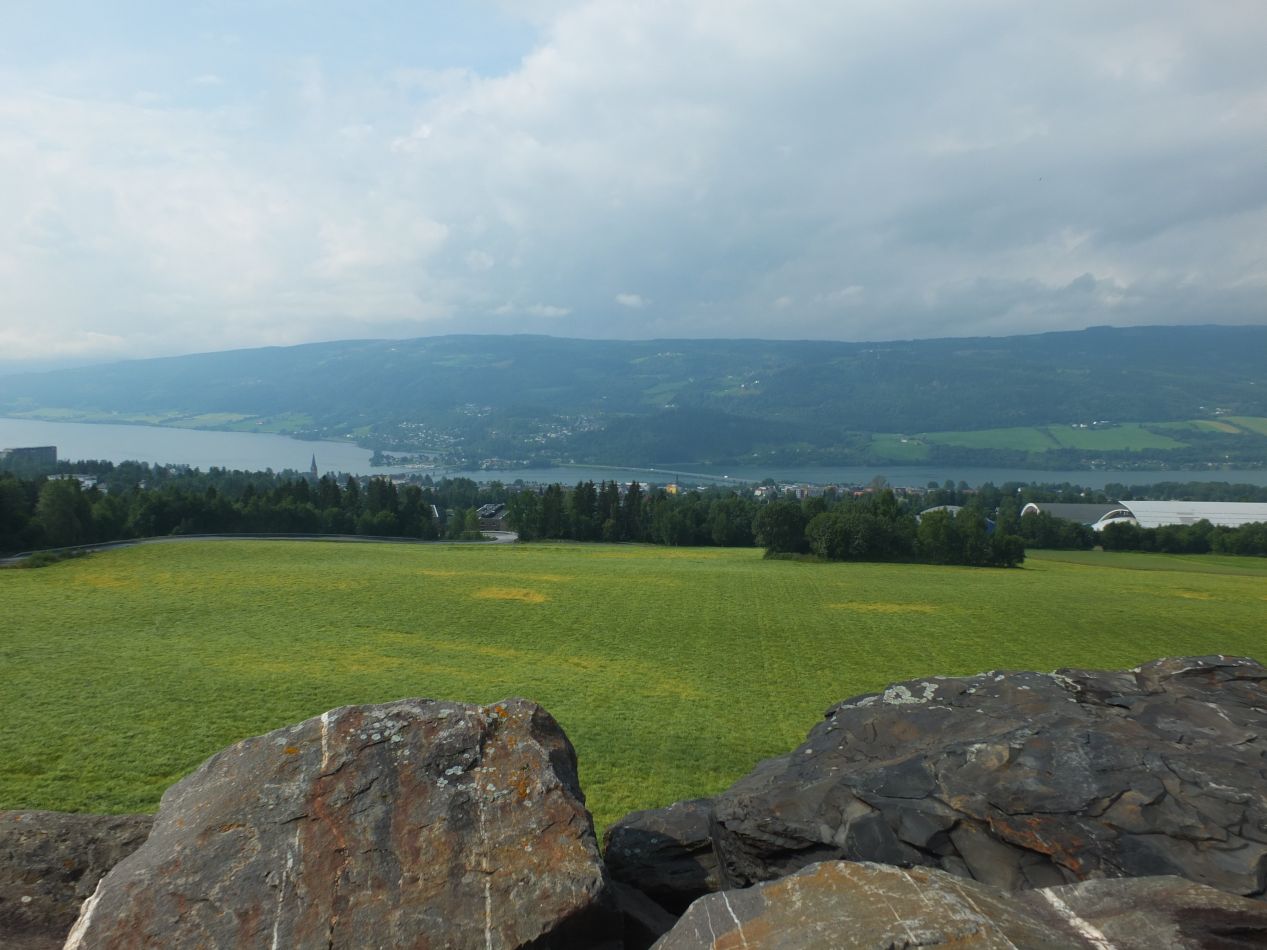


When we finally reached the ski jumping center (Lysgårdsbakkene), we found the Olympic content that had been lacking elsewhere. The enormous ski jumps themselves were the featured attraction here, with the apparatus used for competitions located on the left and a smaller ramp used for training to be found on the right. There was a small stadium encircling the base of the ski jumps that could seat several thousand people, with a gondola to carry visitors up to the top of the hill and a few buildings off to the side. That was pretty much it; this was a spartan setup to be sure. I imagine things are a bit livelier in the winter months when there's actual skiing taking place. The stadium also contained the Olympic Torch, where the eternal flame was kept burning throughout the games. A staircase to nowhere led up there, one of the more amusing engineering designs I can remember seeing. It looks really strange to see a freestanding staircase with no platform at the top. Liz took a picture of me pretending to light the torch, which everyone who visited had to climb the stairs and imagine themselves doing. I distinctly remember when the Olympic Torch was lit during the 1994 Olympics; a Norwegian skiier jumped down the platform while holding the torch and then landed and lit the big flame. I'll go ahead and link it here through the magic of YouTube. It was extremely impressive, topped only by the archer who lit the Olympic Flame at the 1992 Barcelona games by shooting a flaming arrow halfway across the stadium on live TV, hitting his mark perfectly on the first try. I still can't believe that really happened.

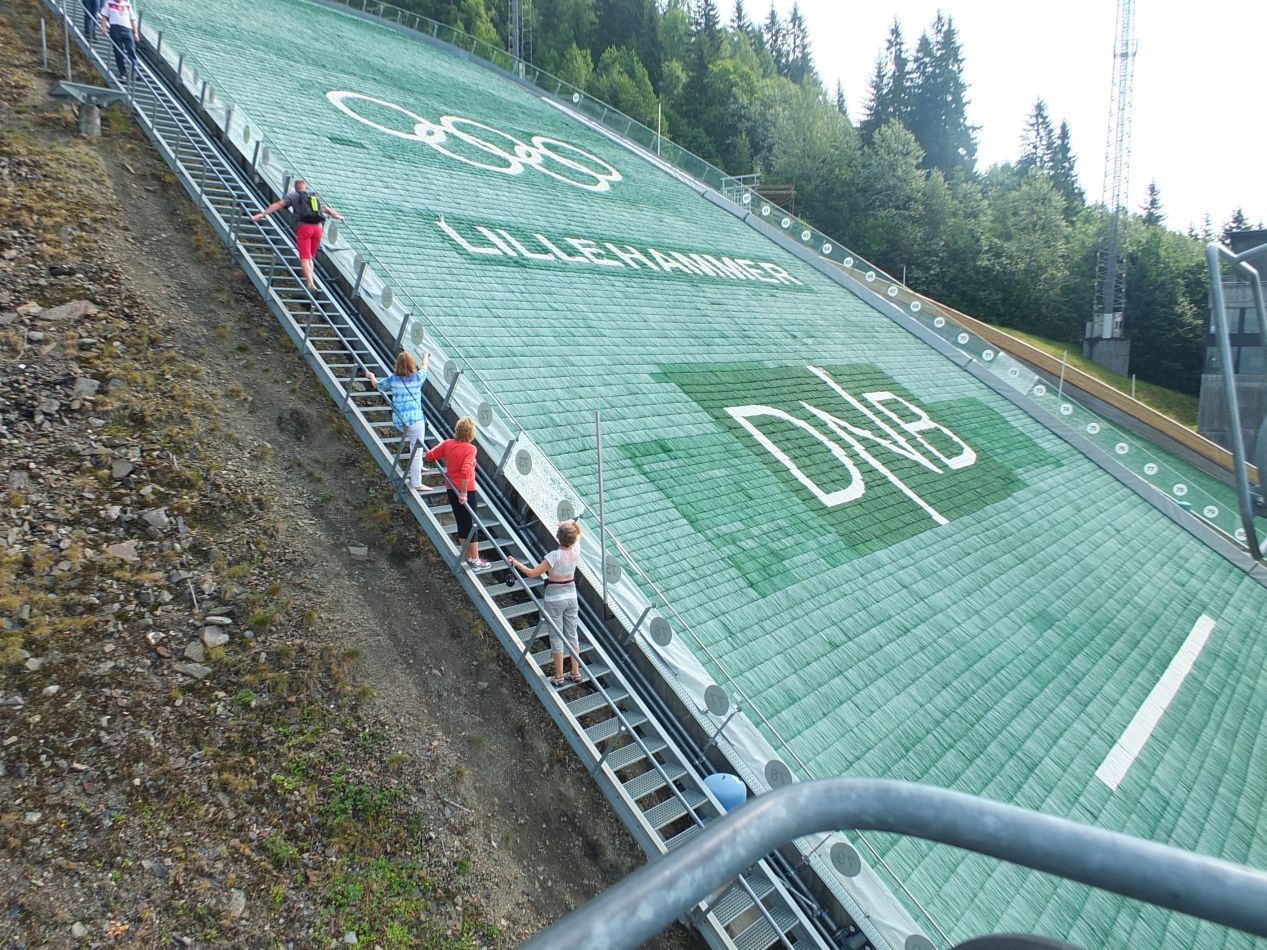


Now that we were here, we might as well climb up to the top of the hill and get the view of the ski jumping platform from above. We decided to split up and take the two different approaches, with Liz riding the gondola chair and me taking the steps. I'm visible in the dark shirt in the third picture above, roughly halfway up the long staircase and beginning to regret my decision. The view from the side of the hill was dizzying, especially when turning to look backwards down the path. Somehow the jumping surface looked even steeper up close, with the surface made up of small strips of green plastic. The numbers on the side indicated how many meters the distance was from the launching point at the top. Norway won both gold and silver in the normal ski jumping event held here, with gold medalist Espen Bredesen jumping 140 meters on both of his attempts to win by a wide margin. Once we were at the top, we were able to get the same view that the jumpers had:


It was a beautiful unobstructed view leading down to the town of Lillehammer and the lake below. Now I'm generally pretty good when it comes to heights, and there are relatively few athletic pursuits that I'm not willing to try doing. Ski jumping is one of the exceptions to that rule. There's no way that anyone is going to get me to launch myself off a hill and fly over 100 meters (!!!) in the air. These jumpers are completely crazy.  It's fun to watch during the Olympics though!
It's fun to watch during the Olympics though!


We were hoping to find some kind of Olympic information center near the ski jumps. We had heard that there was an Olympic museum of some kind in Lillehammer, and logically this would have been the place for it to be located. However, after walking around some of the concrete buildings and peeking in some of the windows we couldn't find anything of the sort. We started walking towards the other destination that we were planning to visit in town, an outdoor museum known as Maihaugen on the eastern side of the town. We weren't exactly sure where it was located and knew only the general direction. Rather than take the long and twisting road that had led up to the ski jumping complex, we decided to take a shortcut on this path that headed into the woods. That had trouble written all over it, but the trail was well-marked and headed in the direction that we wanted to take anyway. We were slightly concerned when it took us through this mountain stream, and not knowing exactly where we were located or where we were going was a cause for some stress. Still, the scenery was pretty and it was fun to walk together through the woods in the Norwegian countryside. So what if the trail ended up dropping us into a residential area on the other side? It was all part of the adventure.




After wandering around lost and needing to ask directions several times, we finally found the way to our destination of Maihaugen. This was another place that really could have been better marked with signs; we were two streets away and there was no indication that it was anywhere close by. Anyway, Maihaugen was a unique kind of museum, an outdoor exhibition consisting of historic buildings brought from across Norway into one place and made available to the public. The founder was a man named Anders Sandvig, who started a private collection of historic buildings in the early 20th century and eventually saw it grow into this museum. The idea behind the collection was to tell the story of traditional village life in Norway from the medieval period up to the present. There were all kinds of different buildings here representative of small town communities: churches, schools, stores, and even one prison building. These structures were broken down piece by piece at their original locations and then reassembled in Lillehammer as part of the Maihaugen collection. It's one of the more unique exhibitions that we had come across, and feels like a perfect fit for a small town like Lillehammer.
The star attraction of the collection is its church, known as the Garmo stave church after the village in which it was originally built. This stave church was first constructed in 1150, and then expanded in the 1730s with additional cruciform wings on either side. It was destroyed in the 1880s to make room for a newer church, and then salvaged by Anders Sandvig to become part of his collection. We were glad that this little church was saved from demolition and preserved in the museum, as it's tiny and absolutely adorable. For those of you who have played Civilization 6, this is what an actual stave church looks like in practice, although the game uses a different stave church as its model for the artwork. The Garmo stave church is still a fully functioning church that can be entered:




It looked small from the outside and was even smaller on the inside. Everything was made out of wood and reflected difficult living conditions. Without knowing anything at all about Norway's history or climate, it would be obvious that this stave church was built by a community that lived in a cold and dark environment for much of the year. With that said though, the interior of the church was relatively bright with the windows thrown open, and it was clear that a great deal of effort had gone into decorating the tiny interior. Small paintings hung on the wooden walls, a model of a ship dangled from the ceiling, and the microscopic altar had a series of detailed carvings behind it that must have taken a lot of time to produce. There was even a miniscule second floor in the back to seat more parishioners. I was left wondering what the maximum capacity would be for this stave church; maybe 50 people at the most with a lot of crowding. The guide inside stated that the church still performs weddings today, which would be a great way to cut down on the guest list. I continued to be impressed at the sheer scope of the different churches that I had encountered on this trip, ranging from the large and mighty to the small and humble.




There were lots of other buildings at Maihaugen, roughly 200 of them in total spread out inside a large fenced-in area. Most of them were family homes or individual residences, typically dating from the 17th or 18th centuries, sometimes standing alone and sometimes grouped together into small communities. All of these houses were wooden, and most of them had the sod roofs traditional in Scandinavia. The sod roofs were designed to be cheap to build while also keeping out water and retaining heat during the bitterly cold winter months. We also came across a number of traditional farmyard animals, goats and sheep and this small horse. This is the famous horse Bronen who has a sign saying "horse can bite". I don't know much about horse breeds, but this one seemed design to handle the cold weather with its smaller size and shaggy fur. This guy wasn't the friendliest horse and mostly wanted to be left alone to keep eating the grass underfoot.

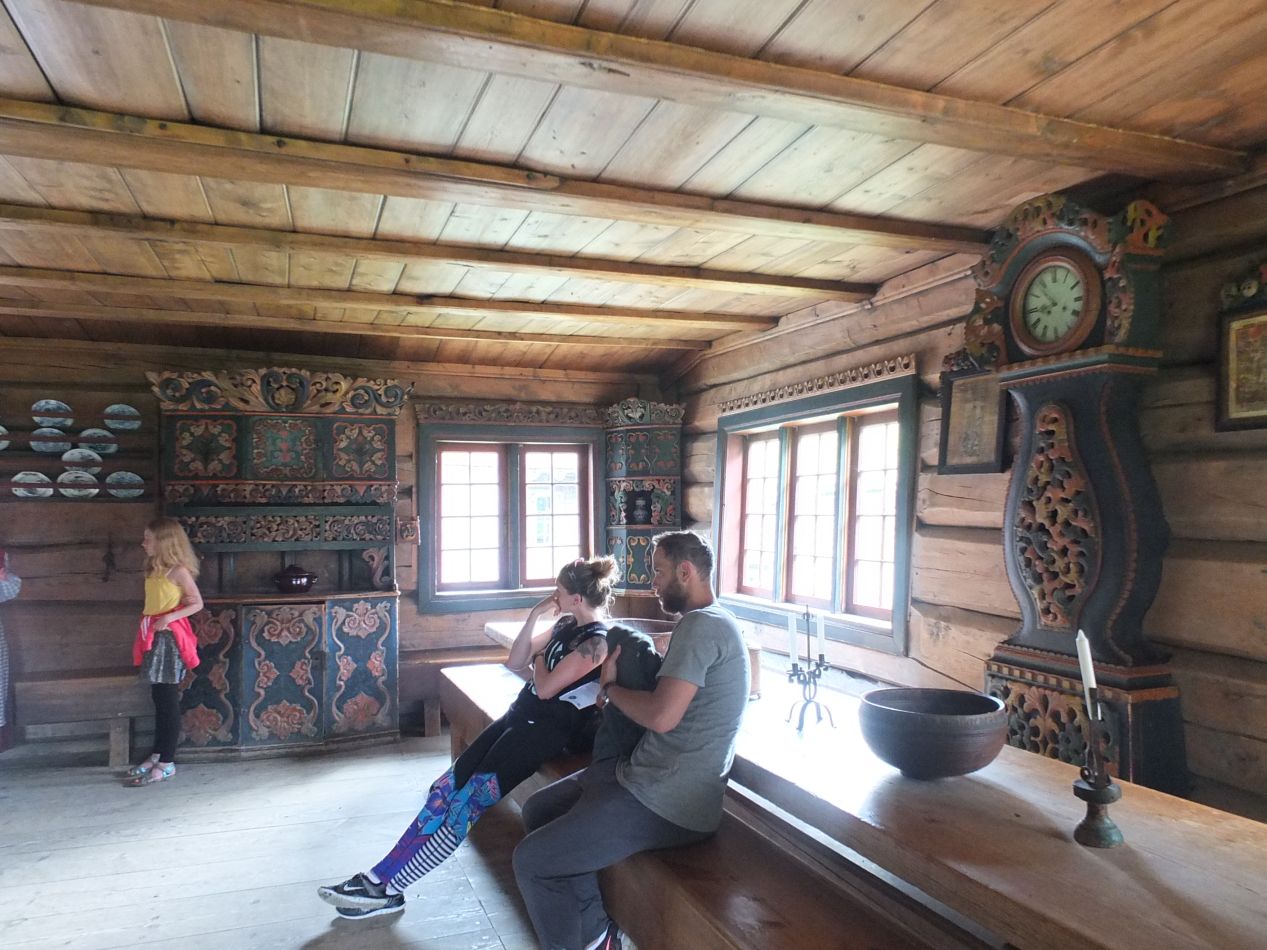


Then there were the interiors of the buildings. A surprising number of them were open and could be explored inside; we thought again that this would be an amazing place to bring kids and let them run around exploring everything in sight. The interiors were furnished to appear as they would have looked at the time of their construction. Most of the ones that we saw looked to date from the 18th century, and they had a warm and cozy feeling to them. (I'm sure that actual houses from this period wouldn't have been nearly so clean in an era without running water.) There were bookshelves and clocks, porcelain plates for eating and spinning wheels for weaving clothes. We should be careful here though, as I don't want to overly romanticize this lifestyle. Premodern village life was full of backbreaking daily labor, and survival could be a daily struggle in some of these remote communities that had little contact with the rest of the world. With that said, it's fascinating to see the environments in which these people lived, and remember that this was what life looked like for most of society as recently as six or seven generations ago. Less than that in many parts of the world. Visiting Maihaugen really was like stepping back in time, albeit to a somewhat idealized version of it.

This was my favorite building along with the stave church: a schoolhouse! I feel a special attachment to schools after spending so many years attending them, and my mother was a teacher for over 30 years on top of that. This was a chance to see what a traditional Norwegian schoolhouse looked like, this one dating from the 19th century. There were four rows of wooden benches with a writing surface on top, and that was basically it in terms of amenities. The woman at the front in traditional dress was giving some kind of lesson to the visitors; it was in Norwegian so we didn't stick around to try and listen. When I visit places like this, I try to imagine what it would have been like to grow up in such a place, and to have had this as my schooling experience. This kind of schoolhouse isn't very far removed in time at all; my grandparents likely grew up with something not much different from this.




We ate a late lunch at the cafe attached to the Maihaugen ticket office, and then prepared to visit the Norwegian Olympic Museum. Yes, we had finally found the location, which was part of the same group of buildings that housed Maihaugen as well as a postal museum of some kind that didn't interest us. The small museum was officially dedicated to Norway's Olympic athletes, but in practice most of the exhibits inside were related to the Lillehammer games in some way. I was amused at the brief history of the modern Olympic games that the museum provided, which included the phrase, "despite its honorable intentions the Olympic ideal has met with many challenges," such as their use as propaganda spectacles by repressive regimes. With autocratic rulers seemingly the only ones interested in meeting the ridiculous criteria set by the IOC for hosting the games, this appears to be getting worse with time, not better. The museum also proudly claimed that the Lillehammer games had been the best ever, which was the identical claim made when I visited Lake Placid and Salt Lake City. Everyone thinks that they're the best. (Note though the torch next to that quote: that's the actual torch used by the ski jumper to light the Olympic Torch at the opening ceremonies. Probably the best artifact in the whole museum.)




There were also profiles of many different Norwegian Olympic athletes along with some of the medals they had won in competition. The Lillehammer medal design was a bit disappointing, using a weird stick figure mascot as the main design element. I liked the Albertville and Nagano designs a lot more, and especially the Vancouver medals that incorporated the Native American art style of the Pacific Northwest into the background. It's also noteworthy how much bigger and more expensive the medals have gotten over time. The gold medal from Squaw Valley in 1960 looked to be about the size of a quarter, while the Vancouver medals would be almost as big as person's hand. With this being Norway nearly all of the Olympic athletes were related to winter sports of some kind, but there were a few winners from the summer games as well. Handball was no surprise, with the sport being so popular in Europe and having a virtually nonexistent presence elsewhere. Some of the other medals here came from fencing and taekwondo. Then there was Jon Ronningen and his incredible mullet, with two medals won for wrestling in the 1980s. With hair like that I'm not sure how he could have ever lost a match.

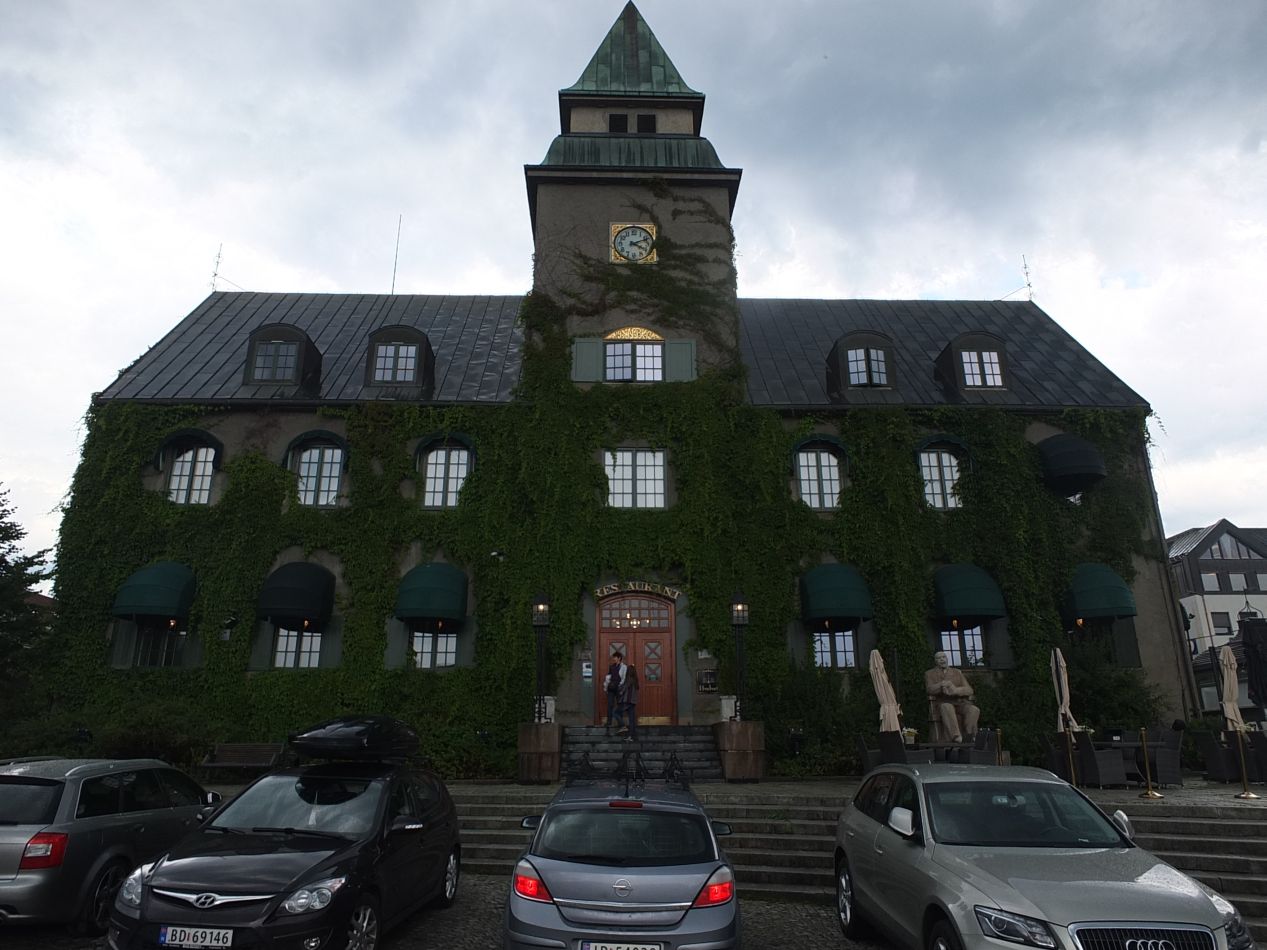


We finished up the day by walking around the streets of Lillehammer's town, visiting some of the small shops and stores that lined the central pedestrian area. Many of the stores were selling traditional Norwegian garments of some kind, and it would have been fun to purchase some of them if they hadn't been so expensive. The weather had been mostly cloudy throughout the day, and now it finally began a light rain outside that kept us from wandering around too much further. That gave these pictures a bit of a gloomy cast even though the town of Lillehammer couldn't have been more pleasant. We spent about an hour here while waiting for the next train to arrive, and then headed back to Oslo.

That was the end of our stay in Oslo, with another trip by train set to begin the next morning. We had enjoyed our time in the Norwegian capital, and if we preferred Copenhagen by a little bit, it was largely due to the fact that we didn't have enough time to see everything that we wanted here. Another day or two would have been nice to explore more of the museums and see some of the tours that we had been forced to pass up. At the same time, we were happy that we had ended up going to visit Lillehammer. We did finally get to find the Olympic museum, the views from the top of the ski jumping slope were amazing, and the outdoor Maihaugen museum was much better than either of us had been expecting. I'll finish this page with one picture of the two of us at the foot of the ski jumping center, standing next to the Olympic Torch. We would be staying in Norway for the next leg of our trip, this time heading to Bergen and the fjords on the western coast. The upcoming trip would prove to be bumpier than either of us could have expected, and it would make for a memorable travel story indeed.



